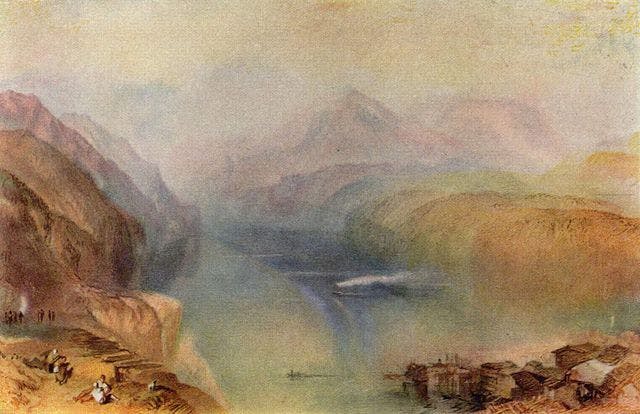Poem of the Day: ‘Alcaics’
The poem’s narrator, sequestered in the Alps, receives from a friend copies of old poetry, and he imagines how the happy singing of youth becomes part of the deposit of art, long after the poets have faded away.

On Wednesday, in this week of classical meters in English poetry, we noted that the sapphic stanza was born on the island of Lesbos around 600 B.C., thanks to the poet Sappho. The alcaic stanza of Ancient Greek and Latin poetry was born on the same island around the same time, thanks (tradition holds) to the poet Alcaeus. And just as English poets have tried to make our half-German, half-French accentual language speak in the quantities of hendecasyllabics, dactylic hexameter, and sapphics, so English poets have turned their hand to alcaics.
As always, it was the Victorians — trained as schoolchildren in Latin literature — who made the most concerted effort. Tennyson, for example, produced alcaics in praise of Milton: “O mighty-mouth’d inventor of harmonies, / O skill’d to sing of Time or Eternity.” Arthur Hugh Clough gave us more alcaics, and so, among others, did Robert Louis Stevenson (1850–1894).
The alcaic stanza, as the English poets developed it (following Horace’s Latin more than Alcaeus’ Greek), consists of four lines. The first two hendecasyllabic lines open with a spondee (two stong syllables in a row), with a dactyl in the penultimate foot: DUM DUM da DUM da DUM da da DUM da. And then the alcaic stanza adds a nine-syllable line and a ten-syllable line, the whole thing measured in accents rather than the length of the vowels.
Stevenson’s “Alcaics” is one of the most successful examples in English: “Brave lads in olden musical centuries / Sang, night by night, adorable choruses.” It’s hendecasyllabic with a twist, and it uses the falling off of the last two lines in the stanza to suggest its theme. The poem’s narrator, sequestered in the Alps, receives from a friend copies of old poetry, and he imagines how the happy singing of youth in alehouses becomes part of the deposit of art, long after the poets have faded away.
Alcaics: To H.F.B.
by Robert Louis Stevenson
Brave lads in olden musical centuries
Sang, night by night, adorable choruses,
Sat late by alehouse doors in April
Chaunting in joy as the moon was rising.
Moon-seen and merry, under the trellises,
Flush-faced they play’d with old polysyllables
Spring scents inspired, old wine diluted:
Love and Apollo were there to chorus.
Now these, the songs, remain to eternity,
Those, only those, the bountiful choristers
Gone — those are gone, those unremember’d
Sleep and are silent in earth for ever.
So man himself appears and evanishes,
So smiles and goes; as wanderers halting at
Some green-embower’d house, play their music,
Play and are gone on the windy highway.
Yet dwells the strain enshrined in the memory
Long after they departed eternally,
Forth-faring tow’rd far mountain summits,
Cities of men or the sounding Ocean.
Youth sang the song in years immemorial:
Brave chanticleer, he sang and was beautiful;
Bird-haunted green tree-tops in springtime
Heard, and were pleased by the voice of singing.
Youth goes and leaves behind him a prodigy —
Songs sent by thee afar from Venetian
Sea-grey lagunes, sea-paven highways,
Dear to me here in my Alpine exile.
___________________________________________
With “Poem of the Day,” The New York Sun offers a daily portion of verse selected by Joseph Bottum with the help of the North Carolina poet Sally Thomas, the Sun’s associate poetry editor. Tied to the day, or the season, or just individual taste, the poems will be typically drawn from the lesser-known portion of the history of English verse. In the coming months we will be reaching out to contemporary poets for examples of current, primarily formalist work, to show that poetry can still serve as a delight to the ear, an instruction to the mind, and a tonic for the soul.
